The Gaijin Tax?
A few years ago, I went to Akihabara and tried to buy some cables at a shop there. The four cables I got were in boxes with prices clearly marked; the total was ¥500 ($4.20). The guy at the counter tried to charge me ¥1380 ($11.60). I later realized that my dress was different—I probably looked more like a tourist, so they probably figured that I would pay without question.
At the time, I was pretty shocked; this really had not happened to me much in Japan. It happened in Europe when I visited, like the bakery counter lady in Athens who crassly gave me way too little in change, and when I complained, she took it back and gave me even less. I never imagined that happening in Japan.
However, I have noticed that recently, clerks “accidentally” make “mistakes” with me quite often.
Just the other day, Sachi and I went to a local burger joint, and got a standard lunch set each. There was nothing on the menu more than a thousand yen (less than ten bucks). Even the beer I ordered only cost a few dollars when swapped out for the drink that came with the lunch set. So, for two people, the total should never be more than, say, ¥3000. Even that’s a bit high.
So when I went to pay, I was rather shocked that the total was more than ¥5500 (about $50). The restaurant guy, who had served us and knew that there was only the two of us and we had not ordered anything special, had rung up the total, announced it to me, and then stood there waiting for me to pay.
The thing is, the amount was so far off it stood out like a sore thumb—like going to McDonald’s, ordering two Big Macs, and getting asked to pay $25.
This guy was not a newbie, we’ve seen him since last year; he maybe even owns the place. The total should have immediately stood out to him as incorrect, more than it did to me. But it took me to give him a puzzled expression—for several seconds, no less—before he caught the “mistake.” I put that in quotes because, frankly, I don’t think it was a mistake.
The thing is, after this happened, I began to recall other similar incidents over the past few years. I always just discounted them as errors, and maybe in fact they were—but the thing is, they are happening with increasing frequency, and are typically not minor overcharges. Several times, mostly at restaurants but also at other shops, I have had to check the tally carefully when I am given a total that seems suspiciously high. So much so that I now almost reflexively check my receipts, even when the total doesn’t seem unusually high.
Generally, I am beginning to get the feeling that this is a “gaijin” thing—something that’s happening because I’m a foreigner here. If so, it is relatively new; this never happened with such frequency before. (Although I would be interested to hear if Japanese people get the same thing as often as I do.)
I’m not counting the trivial stuff, like the conbini that gave me a 100-won coin instead of a 100-yen coin in my change (the Korean coin is worth 1/10th the Japanese currency), or whoever it was at McDonald’s giving me a single patty in a double burger. Just the times when the amount I am asked for is significantly over the total I am supposed to pay.
In Japan, when they give you change, it is (or at least used to be) customary for them to politely ask you to check the change to make sure it is accurate. I never really used to do that because it was always right. Now, I don’t hear them saying that as much—and I’m checking the change a lot more now.


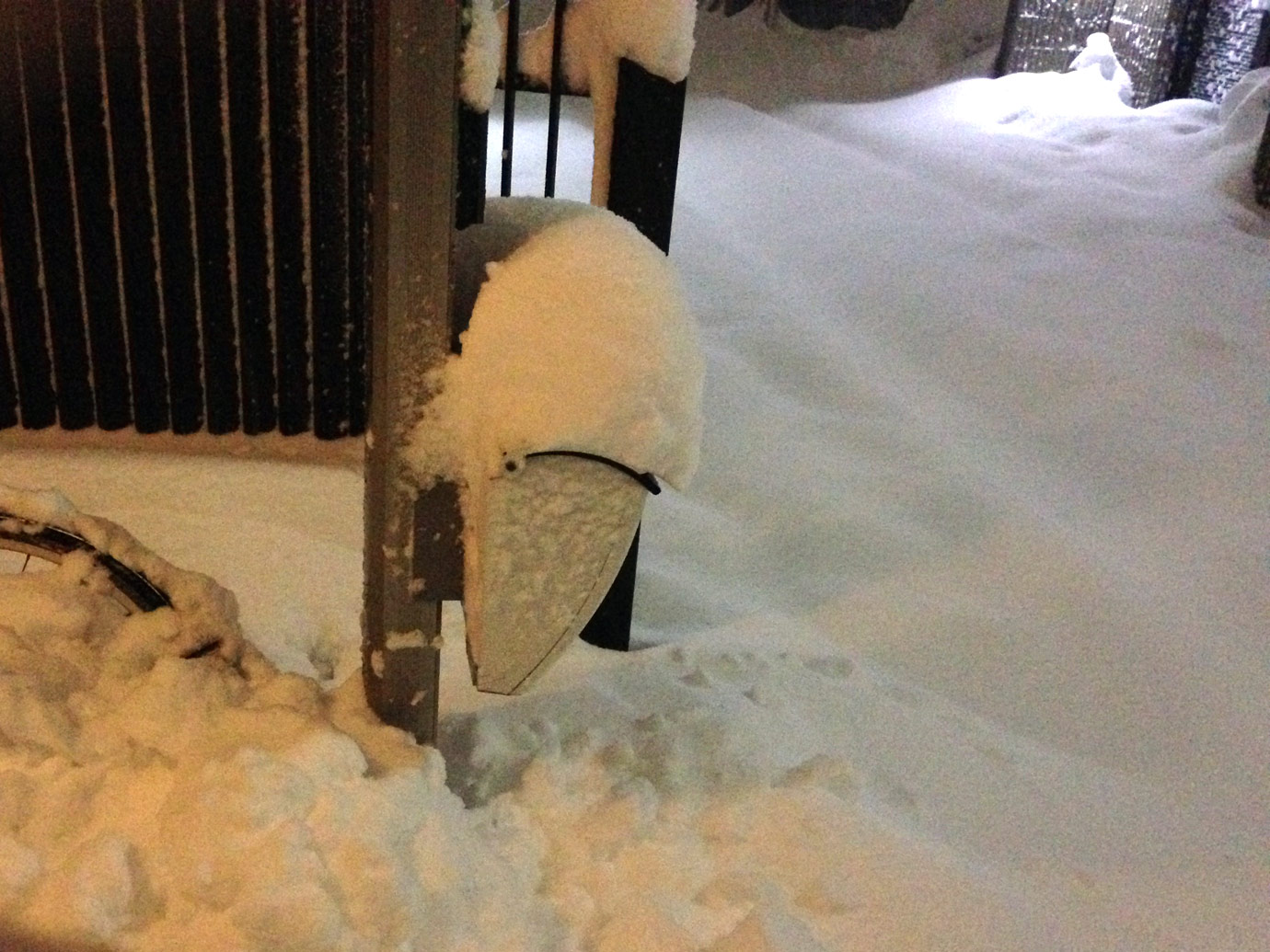








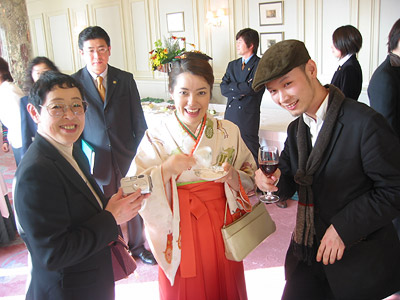
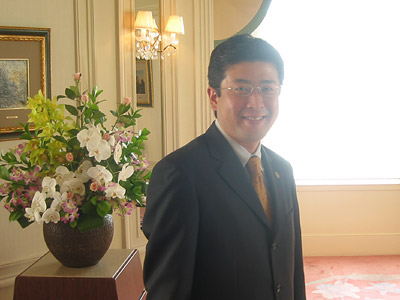


 Well, it is exactly a month before Christmas, and I’ve noticed people putting up their Christmas decorations recently; scattered apartments and houses around Tokyo putting up lights, stores with the usual displays, playing Christmas carols for store music. Even though Japan is predominantly Shinto and Buddhist, with Christians forming a minority 1% or so, Christmas is nonetheless a middlin’-to-big thing over here, for much the same reason it is in the U.S.: commercialism. But with a Japanese twist.
Well, it is exactly a month before Christmas, and I’ve noticed people putting up their Christmas decorations recently; scattered apartments and houses around Tokyo putting up lights, stores with the usual displays, playing Christmas carols for store music. Even though Japan is predominantly Shinto and Buddhist, with Christians forming a minority 1% or so, Christmas is nonetheless a middlin’-to-big thing over here, for much the same reason it is in the U.S.: commercialism. But with a Japanese twist.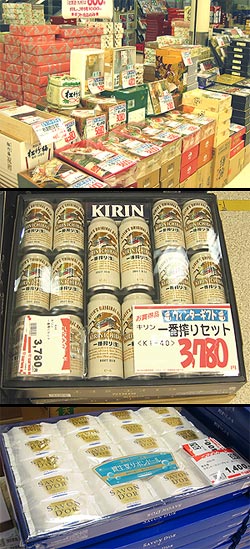 marks the Chugen season, the winter one is called Seibo. Each one is marked by a special gift section created in stores across the country, sometimes taking up as much as half of a floor of a department store. In such gift areas you’ll find a plethora of items, popular ones including small rolled hams, and a wide variety of product packs–a 20-piece soap package, a 15-can beer package, packages with assortments of cookies, coffees, salad oils, fruit juices, canned seafood, and countless other consumer items. One buys gifts here and either gives them or has them delivered to the recipients. The Seibo gift centers are already open for business.
marks the Chugen season, the winter one is called Seibo. Each one is marked by a special gift section created in stores across the country, sometimes taking up as much as half of a floor of a department store. In such gift areas you’ll find a plethora of items, popular ones including small rolled hams, and a wide variety of product packs–a 20-piece soap package, a 15-can beer package, packages with assortments of cookies, coffees, salad oils, fruit juices, canned seafood, and countless other consumer items. One buys gifts here and either gives them or has them delivered to the recipients. The Seibo gift centers are already open for business.
 Well, the school had its Arts Festival yesterday, and it was amazing to see the talent so many of our students have. Not just your usual skits at the talent show–we have some serious composers, musicians, singers… One student, for example, played original piano compositions that were astounding. I was in back when another started singing “The Heart Must Go On,” and I swore that I was listening to a recording of Celine Dion. Paintings by some of the students I honestly mistook for art that the live house had purchased, and there was a fantastic brass section that performed “In the Mood.” Seven students made up a punk rock band, playing a popular Japanese song called “Train, Train” that had many of the students in the audience acting like groupies at a concert. And one of my former students, who I knew was talented, surprised me in showing an array of talents I never expected, from keyboard artist to trumpeter to half a dozen other talents.
Well, the school had its Arts Festival yesterday, and it was amazing to see the talent so many of our students have. Not just your usual skits at the talent show–we have some serious composers, musicians, singers… One student, for example, played original piano compositions that were astounding. I was in back when another started singing “The Heart Must Go On,” and I swore that I was listening to a recording of Celine Dion. Paintings by some of the students I honestly mistook for art that the live house had purchased, and there was a fantastic brass section that performed “In the Mood.” Seven students made up a punk rock band, playing a popular Japanese song called “Train, Train” that had many of the students in the audience acting like groupies at a concert. And one of my former students, who I knew was talented, surprised me in showing an array of talents I never expected, from keyboard artist to trumpeter to half a dozen other talents.











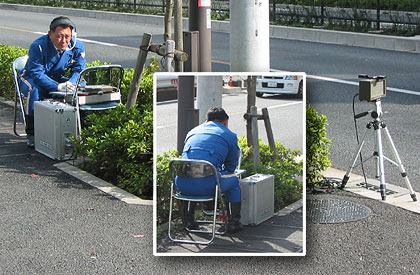
 located strategically so that a speeder cannot turn off somewhere or otherwise get by. A motorcycle cop stands ready to pursue anyone who tries to get away.
located strategically so that a speeder cannot turn off somewhere or otherwise get by. A motorcycle cop stands ready to pursue anyone who tries to get away. works–and there is never a speed trap or even an officer on patrol. In the places where they could do the most good. Instead, the traps are set up on long, wide straightaways with absurdly low speed limits. The street pictured here is a wide (for Japan) two-lane boulevard with little foot traffic (it’s an industrial area). I walked its length and maybe saw one or two pedestrians in total. Very little cross traffic. In other words, probably the place one would least have to worry about accidents happening.
works–and there is never a speed trap or even an officer on patrol. In the places where they could do the most good. Instead, the traps are set up on long, wide straightaways with absurdly low speed limits. The street pictured here is a wide (for Japan) two-lane boulevard with little foot traffic (it’s an industrial area). I walked its length and maybe saw one or two pedestrians in total. Very little cross traffic. In other words, probably the place one would least have to worry about accidents happening.
 When I tried to find a decent, cheap sushi place in the U.S., it was very hard to do. Most places charge several dollars per plate, a lot more than the dollar-a-plate I’ve become used to in Japan. The best I could scrape up was a few all-you-can-eat places in San Francisco, and they were still more expensive, in the end, than the Japan dives (even if I starved myself prior), and the quality just didn’t match up.
When I tried to find a decent, cheap sushi place in the U.S., it was very hard to do. Most places charge several dollars per plate, a lot more than the dollar-a-plate I’ve become used to in Japan. The best I could scrape up was a few all-you-can-eat places in San Francisco, and they were still more expensive, in the end, than the Japan dives (even if I starved myself prior), and the quality just didn’t match up.